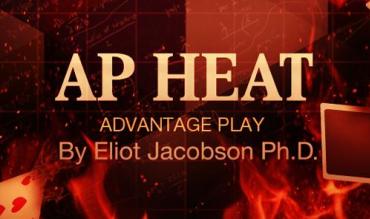When an AP finds a dealer on Ultimate Texas Hold'em (UTH) who is vulnerable to hole-carding, it is not unusual for her to expose the bottom card of every packet of cards she delivers (see this post for an introduction to UTH). This includes exposing one of her two hole-cards as well as one of the common cards. Depending on how the common cards are spread and turned over, the exposed common card will then either be a Flop card or it will be a Turn/River card. This is obviously a very powerful opportunity for the AP. This post considers the situation when the AP sees one dealer hole-card and one Flop card. Recall that the AP gets an edge of 13.5922% with computer perfect play if he "only" sees one dealer hole-card and nothing more (see this post). Obviously, the situation considered in this post is much better.
UTH is not easy to analyze. My program ran for 8 days and 6 hours on four concurrent processes to complete this analysis. This computation involved evaluating 19,233,934,125,120 (19.2 Trillion) different seven card poker hands. In the end, my output listed every possible unique starting situation consisting of two player cards, one dealer hole-card and one Flop hole-card. The program gave the expected value for checking on the hand pre-Flop and for raising 4x pre-Flop, as well as the correct strategy in each case.
I shortened the computation considerably by only considering equivalence classes of starting hands. This reduced the number of starting configurations from 3,248,700 to 187,213.
For example, consider the starting hand player = (2c, 7d), dealer hole-card = 8h, Flop hole-card = Js. For convenience I will denote this as (2c, 7d), (8h), (Js). This hand is equivalent to both (2c, 7d), (8s), (Jh) as well as (2h, 7s), (8d), (Jc). Altogether, this hand is equivalent with 24 hands (including itself). I only needed to evaluate one of those 24 starting hands, and then multiply the result by 24, to get the total contribution for this one hand. The program also output the number of permutations for each starting hand, the "perms."
In particular,
- The player edge in UTH knowing one dealer hole-card and one Flop hole-card is 22.3286%.
- The player makes a 4x pre-Flop raise on 40.2679% of the hands.
- The player checks pre-Flop on 59.7321% of the hands.
In Exhibit CAA, James Grosjean gives the AP an edge of 20.74% over the house using the practical strategy he provided. Evidently, he got that number by simulation and not by running a full cycle. Grosjean does not give the edge of 22.3286% using computer-perfect play. As far as I know, this is the first time this number has been published.
Here are some other facts about hole-carding UTH, knowing one dealer hole-card and one Flop card:
- The best starting hand for the AP is player = (Kc, Kd), dealer = 2c, and Flop = Kh (and its permutations). The player should raise 4x in this situation, with EV = 6.1933.
- The worst starting hand for the AP is player = (2c, 7d), dealer = Qd, and Flop = Qh (and its permutations). The player should check in this situation, with EV = -1.7369.
- The closest pre-Flop decision is when player = (5c, Qd), dealer = 4h and Flop = 7s (and its permutations). In this case, checking pre-Flop has EV = -0.021213 and raising 4x pre-Flop has EV = -0.021223. The difference in EV between checking and raising 4x is 0.0046%.
I am not going to present a pre-Flop strategy. The reader is welcome to create his own by going through the spreadsheet I provided and creating some rules. Also, I am not going to repeat Grosjean's strategy here. In other words, if you want to actually beat UTH, you will either fly by the seat of your pants or else try to get a copy of Grosjean's Exhibit CAA.
As for my advice to fly, about five years ago, two women called me out of the blue saying they had found exactly the situation described in this post. They were not APs, they were just observant and smart gamblers. They said it was so easy to beat that they didn't worry about a strategy. Lucky for the casino, they were betting table minimum ($5). Their interest in calling me was their desire to invent a new casino table game. I managed to talk them out of it.
As far as game protection, I recommend that UTH be hand dealt, using the following procedure:
- After removing the cards from the automatic shuffler, and after each player has made their Ante bet, a card is burned and two cards are dealt face-down to each player.
- The players then look at their cards and make their pre-Flop check/raise decisions.
- Another card is burned, then three Flop cards are dealt and turned face-up.
- The players who have not yet raised then make their Flop check/raise decisions.
- Another card is burned, then two Turn/River cards are dealt and turned face-up.
- The players who have not yet raised then make their Turn/River raise/fold decisions.
- Another card is burned, then two cards are dealt to the dealer and turned face-up.
- All necessary cards have now been dealt, and the wagers can be resolved.
By avoiding dealing cards until those cards are necessary for the next wagering step in the game, there will be no hole-card opportunities. By burning the top card before cards are dealt, there will be no top-card (or marked-card) opportunities. I have observed that this dealing procedure is commonly used in Las Vegas.


